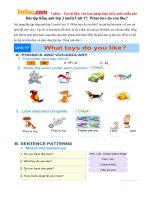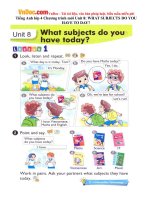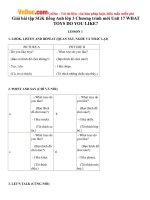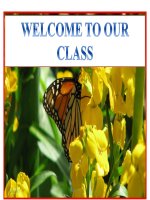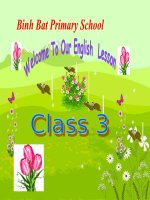Unit 8 What subjects do you have today
Bạn đang xem bản rút gọn của tài liệu. Xem và tải ngay bản đầy đủ của tài liệu tại đây (236.59 KB, 14 trang )
<span class='text_page_counter'>(1)</span>Week: 12 Period:24. Date: Thứ …..ngày ….tháng …. năm 2015. Teaching date: ............................................ UNIT 8: What subjects do you have today? Lesson 1 I. Objectives: By the end of this unit, pupils can use the words and phrases related to the topic School subjects. Ask and answer questions about school subjects, using What subjects do you have? I have… II. Language Focus: + Vocabulary: Maths, Vietnamese, IT, Art, Music... + Sentence pattern: What subjects do you have? I have Vietnamese, Maths and English. III. Resources: Ss’ book, recording, computer, stereo, (projector), books , ... IV. Procedure: Time. 3’. 8’. Learning activities Warm-up: - Spend a few minutes revising the previous leson by asking the class the question What do you like doing? Then have the class Flying a little kite and clap their hands. 1. Look, listen and repeat. - Tell pupils that they are going to read a story in which pupils ask and answer questions about school subjects, using What subjects do you have today? I have… - Have them look at the four pictures to discuss the context in which the language is used. Ask them questions such as Who are they? Where are they? And What are you talking about? (In picture a, Nam and Tom talk about what day it is today. In Picture b, Nam asks Tom Do you have Marths Vietnamese, Maths and English. In Picture d, Tom looks at his wristwatch saying they are late for school, so they have to run.) Check comprehension. - Play the recording more than once, if necessaary, for pupils to listen and repeat. Do choral and. Language Focus. Spoken Interaction.. Spoken interaction. Modes. Whole class. Whole class Individuals. Whole class.
<span class='text_page_counter'>(2)</span> 10’. 8’. individual repetition, pointing to the characters speaking. - Play the recording again for pupils to listen and repeat. * Language note: Maths is the short forn of Mathematiccs 2. Point and say. - Tell pupils that they are going to practice asking and answering questions about school subjects, using What subjects do you have today? I have… - Have them look at the pictures to understand how to name the school subjects. - Point to Picture a and have pupils repeat the word of the subject under it. Do choral and individual repetition. Then tell pupils to practise asking and answering about the subject in pairs, using the prompts in the bubbles and the word under the picture. Repeat the same procedure with the rest of the pictures. - Invite a few pairs to act out the dialogue in front of the class. Check as a class and correct pronunciation. * Language note: Names of school subjects start with capital letters, e.g. Maths, Science. ***Work in pairs. Ask and answer questions about your school. Ask its name and where it is. - Tell pupils that they are going to practice in pairs: one asks and the other answers questions about the actual subjects they have today, using What subject do you have today? I have… - Have them work in pairs, one asking and the other giving the answer. - Call on a few pairs to act out the dialogue in front of the class. Correct pronunciation, if necessary. 3. Listen and tick - Tell pupils that they are going to listen to three dialogues about school subjects and tick the correct pictures - Have them look at the pictures. Ask them what. Individuals. Pairs. New words and structures/ function. Listening Activities. Groups. Whole class Individuals.
<span class='text_page_counter'>(3)</span> 5'. these subjects are called in Enghlish. Have pupils point to the pictures and say aloud the names of the subjects in English. Check understanding. - Play the recording more than once, if necessary. Ask pupils to listen to the recording and tick the correct pictures. Tell them to focus on the subjects - Get pupils to swap their answers before you check as a class. Key: 1. b 2. a 3. c Audio script: 1. Mai: What day is it today, Linda? Nam: It’s Tuesday. Mai: What subjects do you have today? Nam: I have Vietnamese, Art and Maths. 2. Linda: Do you have Maths today, Phong? Phong: Yes, I do. Linda: What about Science? Phong: I don’t have Science. But I have Music and English. 3. Linda: What day is it today? Mai: It’s Thursday. Linda: What subjects do you have today, Mai? Mai: I have English, Vietnamese and IT. 4. Look and write. - Tell pupils that they are going fill the gaps of the sentences with different days of the week and the subjects they have. - Have them look at the pictures to identify the days of the weenk and the subjects they have on each day. Tell them that the days and subjects are written in Vietnamese. Ask them what these days and subjects are called in English. Check understanding. - Ask pupils to find appropriate words to complete the sentence under each picture. - Give them time to do the task independently. Go. Pairs Groups. Whole class Words and structures. Individuals Closed – pairs. Open – pairs Groups.
<span class='text_page_counter'>(4)</span> around and offer help, if necessary. - Get pupils to swap their answers before checking as a class. If there is enough time, call a few pupils to read aloud complete sentences. Key: 1. Monday, Vietnamese, Science and English. 2. Wednesday, has Maths, IT and Music. 3. Friday, have Maths, Science and Art. 5'. 1’. 5. Let’s sing. - Tell pupils that they are going to sing the song What day is it today? Follow the procedure in the Teaching the unit components in the Introduction. - Have them read each line of the lyrics aloud.Check comprehension. - Play the recording all the way through. Ask pupils to do choranl and individual repetition of the song line by line. - When pupils are familiar with the tune, ask a group of four to the front of the class. One group sings the first three lines and the other sings the last four lines. Then the class sings the song What day is it today? Together and claps hands. * Home link: - learnt by heart the school subjects. - practice asking and answering about subjects.. Whole class. Song Groups. Whole class. Anticipated problems: …………………………………………………………………………………………………… …………………………………………………………………………………………………… …………………………………………………………………………………………………… …………………………………………………………………………………………………… …………………………………………………………………………………………………….
<span class='text_page_counter'>(5)</span> Week: 13 Period: 25. Date: Thứ …..ngày ….tháng …. năm 2015. Teaching date: ............................................ UNIT 8: What subjects do you have today? Lesson 2 I. Objectives: By the end of this unit, pupils will be able to ask and answer questions about when someone has a subject, using When do you have?... II. Language Focus: Spoken interaction, words and structures/ function. * Sentence Patterns: When do you have Science? I have it on Monday. III. Resources: Ss’ book, recording, computer, stereo, (projector), poster, picture cards ... IV. Procedure: Time. 3’. 7’. Learning activities. Language Focus. Warm-up: - Spend a few minutes revising the previous Spoken Interaction. lesson by having the class sing the song What day is it today? 1. Look, listen and repeat. - Tell pupils that they are going to look at a story in which pupils ask and answer questions about their timetables. - Give them a few seconds to look at the pictures and read the text. Get them to identify the characters and the setting of the conversation by asking Who’s this? What are they doing? What are they talking about? (In picture a, a friend asks Nam What he is doing, In Picture b, he continues to ask When do you have English? And Nam answers I have it on Mondays, Tuesdays, Thurdays and Fridays. In. Modes Whole class. Spoken interaction Whole class. Individuals. Individuals.
<span class='text_page_counter'>(6)</span> picture c, Nam asks his friend What about you? And the friend says he has English on Mondays, Tuesdays, Wednesdays and Fridays. In Picture d, Nam tells that his teacher is Miss Hien. - Play the recording more than once, if necessary, for pupils to listen and repeat. Do choral and individual repetition, pointing to the character speaking. - Play the recording again for pupils to listen and repeat. If time allows, ask a few pairs to role-play the conversation.. 6’. 10’. 2. Point and say. - Tell pupils that they are going to practice the question and answer When do you have Science? And I have it on… - Let them look at timetable. Ask them to identify the names of the four pupils in the first column and the days when these pupils have Science. Check comprehension. - Point to the first row of the table and get one pupil to ask When do you have Science, Sam? And another to answer I have it on Mondays and Thursdays. Pepeat the procedure with the other rows in the table. - Ask them to work in pairs and ask and answer the question, using the given twct in the bubbles and the information in the timetable. - Call a few pairs to act out the exchanges. 3. Let’s talk - Tell pupils that they are going to revise what they have learnt in Lessons 1 and 2. Get them to work in pairs and ask and answer the three questions. Remind them to answer with facts about themselves. - Call a few pairs to act out their conversation. - Ask them to work in pairs: one asks the questions and the other gives the answers about. Whole class Pairs. Individuals. Pairs New words and structures Say and Respond. Groups. Spoken interaction Whole class Individuals Pairs Groups.
<span class='text_page_counter'>(7)</span> 6’. their own hobbies. Tell pupils that both questions can be used to ask about one’s hobbies. They should practise both with their partners. Monitor the activity and offer help, if necessary. - Encourage pupils to observe and give comments in English. 4. Listen and number. - Tell pupils that they are going to listen to four dialogues about different PE timetables and number them in the order they hear. - Ask them to look at the pictures and identify the days where there is a PE lesson. (a. Tuesdays and Thursdays. B. Tuesdays and Fridays. C. Mondays and Wednesdays. D. Wednesdays and Thursdays.) - Have pupils read aloud the days before playing the recording. - Play the recording more than once, if necessary. Ask pupils to listen and number the pictures. Tell them that they should forcus on the days of the week. - Get pupils to swap their answers before you check as a class. Monitor the activity and offer help, if necessary. Key: a3 b4 c1 d2 Audio script 1.A: What day is it today? B: It’s Monday. Ar: We have PE today. B: Yes, we have it on Mondays and Wednesdays. 2. A: When do you have PE? B: I have it on Wednesdays and Thursdays. A: Today is Thursday. So we have PE. Whole class Individuals. Pairs. Listening Activities. Groups.
<span class='text_page_counter'>(8)</span> today, right? B: That’s right. 3. A: When do you have PE? B: I have it on Tuesdays and Thursdays. A: Today is Thursday. So we have PE today. B: That’s right. 4. . A: When do you have PE? B : I have it on Tuesdays and Fridays. What about you? A: Me too.. 5’. 2'. 5. Look and write: - Tell pupils that they are going to complete the sentences, using the given timetable. - Give them a few seconds to look at the timetable and read the text. Then check comprehension by asking When does the pupil have English? - Set a time limit for the task and offer help, if necessary. - Check the answers as a class and call one or two pupils to read aloud the completed text. Key: English, Wednesday, Wednesday(s). Writing activities. Individuals. Words and structures. 6. Let's play:. - Ask them to look at the word SUBJECTS and the rows of boxes 1 to 5. Have pupils think about the names of the subjects bearing one letter of the word SUBJECTS and complete the puzzle, using one letter per box. Do Number 1. Pairs. -Whole class. - Tell pupils that they are going to do the puzzle Supportive activities by writing the names of the school subjects.. Whole class. to reinforce learning.
<span class='text_page_counter'>(9)</span> as an example: SICENCE.. Game. - Ask pupils to work in pairs to discuss the. - Individual. possible answer. Go around offering help. If necessary. - Call on some of them to say the answers.. 1’. Key: 1 Science 2.Music 3.English 4.Vietnamese 5.Maths * Home link: - Practice asking and answering about subjects.. Whole class. Anticipated problems: …………………………………………………………………………………………………… …………………………………………………………………………………………………… …………………………………………………………………………………………………… …………………………………………………………………………………………………… …………………………………………………………………………………………………… …………………………………………………………………………………………………… Week: 13 Period: 26. Date: Thứ …..ngày ….tháng …. năm 2015. Teaching date: ............................................ UNIT 8: What subjects do you have today? Lesson 3 I. Objectives: By the end of the lesson, pupils will be able to pronounce the sounds of the letters ct and cts in the words Subject and subjects respectively. II. Language Focus: Spoken interaction, phonics. + ct subject English is my favourite subject. + cts subjects What subjects do you have today? III. Resources: Ss’ book, recording, computer, stereo, (projector), poster, sound card ... IV. Procedure: Time 3’. Learning activities. Language Focus. Modes. Warm-up: - Spend a few minutes revising the previous lesson by organising a Slap the board game using the words for school subjects.. Spoken Interaction. Game.. Whole class.
<span class='text_page_counter'>(10)</span> 8’. 6’. 1. Listen and repeat. - Tell pupils that they are going to practise saying the sounds of the letters ct and cts in the words subject and subjects respectively. - First, put the letters ct and cts on the board. Play the recording and ask pupils to repeat a few times. Then put the words subject, subjects and the sentences on the board. Play the recording more than once, if necessary, and let pupils say the words and the sentences, paying attention to the target sounds. - Do choral and individual repetition of the sounds, words and sentences until pupils feel confident. - Get some pupils to say the sentences in front of the class. Correct the pronunciation, if necessary. 2. Listen and tick. Then write and say aloud: - Tell pupils that they are going to listen to the recording and tick the correct boxes. - Give them a few seconds to read the sentences in silence and guess the words to fill the gaps. - Have pupils listen to the recording and tick the appropriate boxes. Then ask them to fill the gaps with subject or subjects. Have them swap their answers before checking as a class. Go around offering help, if necessary. - Ask pupils to read the sentences aloud. * Key: 1. subjects 2. subject 3. subjects 4. subject Audio script 1. What subjects do you have today? 2. What subject do you like?. Whole class Individuals Whole class Individuals Phonics. Phonics. Whole class. Individuals. Pairs/ groups.
<span class='text_page_counter'>(11)</span> 3. What subjects does she have on Fridays? 4. What subject does she like?. 10’. 3. Let’s chant. - Tell pupils that they are going to say the chant What subjects do you have today? Follow the procedure in Teaching the unit components in the Introduction. - Have them read the chant and check comprehension. - Play the recording more than once, if necessary, for pupils to do choral and individual repetition. Show them how to chant and do actions. Call two Spoken interaction groups of three to give a demonstration, one group chants the three questions and the other chants the three answer. - Get pairs or group to sit opposite of each other and practice chanting and doing actions. Go around offering help, if necessary. - Call two groups of three to the front of the class to chant and do actions. The rest of the class claps along to the rhythm.. Whole class Individuals Pairs Groups.
<span class='text_page_counter'>(12)</span> 7’. 5’. 5’. 4. Read and complete: - Tell pupils that they are going to read the text about Nga and complete the timetable. - Get them to look at the timetable and guess the subjects they can use to fill gaps. Then have them read the text to find the information they need to complete the task. If necessary, get them to work in pairs. - Give pupils time to do the task independently. Go around to offer help, if necessary. - Get them to swap and check their answers before checking as a class. Key: 1. Vietnamese 2. Maths 3. Science 4. Art 5. Write about you and your school subjects - Tell pupils that they are going to complete some sentences about their school subjects. - Have them work in pairs or groups to discuss what words they are going to fill the gaps with. Focus pupils on their school, the school days, the school subjects, when they have English, and their favourite subject. - Give pupils time to do the task independently. Go around to offer help, if necessary - Get pupils to swap and check their answers before checking as a class. - If there is time, ask one pupil to write the email on the board. Key: Pupils’own answers 6. Project - Tell pupils that they are going to interview a friend in another school about his/her timetable. Whole class Individuals Pairs Groups. Reading activities. Whole class Individuals Pairs Supportive activities to reinforce learning. Groups. Words and structures. Supportive activities to reinforce learning. Whole class.
<span class='text_page_counter'>(13)</span> and tell the class about it. - Give each of them a small piece of paper and ask them to copy the table in the Pupil ’s Book on the paper. - Tell pupils to ask a friend in another school about his/her timetable during break time and tick the table. - Have them tell the class about their friends’timetables Example: Vietnamese Maths English Science IT Music Art PE. Monday. Tuesday. v v v. v v. Wednesday v v v. v. Thursday v v v v. Friday. Individuals. Pairs. Groups. v. v v v v. He is my friend’s timetable. Huong is a pupil at Quang Trung Primary School. She has Maths and Vietnamese on Mondays, Tuesdays, Wednesdays and Thurdays. She has English on Mondays, Wednesdays, Thursdays and Fridays. She has Science on Tuesdays and Thursdays. She has IT and Music on Wednesday, and Art on Tuesdays. She has PE on Fridays. Thank you for listening. Key: Pupils’own answers. 1’. * Home link: - learnt by heart the chant.. Whole class. Anticipated problems: …………………………………………………………………………………………………… …………………………………………………………………………………………………… …………………………………………………………………………………………………… …………………………………………………………………………………………………… …………………………………………………………………………………………………….
<span class='text_page_counter'>(14)</span> …………………………………………………………………………………………………… …………………………………………………………………………………………………… …………………………………………………………………………………………………… …………………………………………………………………………………………………… …………………………………………………………………………………………………….
<span class='text_page_counter'>(15)</span>
